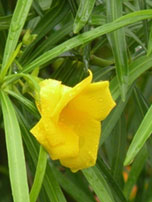SHAHEED KARTAR SINGH SARABHA AYURVEDIC MEDICAL COLLEGE & HOSPITAL
Affiliated to Guru Ravidas Ayurved University, Hoshiarpur Punjab
Affiliated to Guru Ravidas Ayurved University, Hoshiarpur Punjab

Botanical Name : Thevetia neriifolia Juss.
Family : Apocynaceae
Names in different Indian languages :
English: yellow oleander, exile tree, exile oil tree, milk bush
Uses :
fruit pulp Food: general leaf bark Medicines: emetics leaf bark Medicines: laxatives, etc. bark Medicines: menstrual cycle bark Medicines: fabrifuges whole plant Phytochemistry: glycosides, saponims, steroids wood Phytochemistry: fish-poisons fruit Phytochemistry: insecticides, arachnicides plant Phytochemistry: arrow-poisons plant Phytochemistry: ordeal-poisons Phytochemistry: miscellaneously poisonous or repellent seed Phytochemistry: fatty acids, etc. plant Agri-horticulture: ornamental, cultivated or partially tended Agri-horticulture: hedges, markers Agri-horticulture: shade-trees leaf Products: tobacco, snuff all parts Products: exudations-gums, resins, etc. wood Products: household, domestic and personal items
Morphology :
A shrub to 6 m high, native of central and tropical S America from Mexico and the West Indies to Brazil, and widely distributed by man, occurring in the West African region as a garden cultivate.The foliage is not grazed by stock. The plant makes an useful enclosure hedge. It stands clipping, endures drought and suppresses plants from its shade. In the West Indies half a leaf is known as an emetic and purgative. In Java Indian immigrants are reported to smoke the dried leaves. Tincture of bark is also emetic and purgative, and has been used as a febrifuge, but tests with bark and fruit extracts have proved inactive against avian malaria. In Senegal a macerate of bark and leaves may occasionally be used with precautions for amenorrhoea. The wood is used in Ghana sometimes to make axe-handles. In Indonesia it is reported used as a fish-poison. The fruits have shown some insecticidal activity, and especially the kernels. All parts of the plant are poisonous. It has been used in southern Africa as an arrow or ordeal-poison. A number of glycosidal derivatives of cardenolide have been detected of which thevetin is present throughout except in the leaves and fruit-pulp. The leaves contain several other glycosides including neriantin. The former substance is cardio-toxic acting like digitalis, but only fractionally as strong. It has been suggested as a substitute for use in digitalis-intolerance. The kernel contains another and more toxic bitter principle which causes tetanic convulsions and speedy death for which it is commonly used in India for suicide and murder. In southern Africa it has acquired the name ‘be-still nut.’ There is in the kernel a pale yellow fixed oil amounting to 57–62%. Raw, of course, it is poisonous, and is used in external application in India to areas of skin-infections. It can be freed of the toxic principles and is then fit for culinary purposes. It consists mainly of glycerides of oleic acid. The fruit pulp is sometimes eaten in Ghana without any apparent ill-effect. Latex is found in all parts of the tree. It sets to a resinous substance rich in ash: 47.9% resins, 20.4% ash. The plant also contains a dark coloured gum which is tasteless and mainly insoluble but swelling in water
